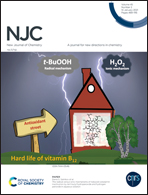High performance cobalt nanoparticle catalysts supported by carbon for ozone decomposition: the effects of the cobalt particle size and hydrophobic carbon support†
Abstract
Catalytic gaseous ozone decomposition under high humidity is not only an urgent need but also a significant challenge because of the low stability over the available catalysts. By the pyrolysis of ZIF-67 materials, a series of cobalt nanoparticle catalysts with tunable size and supported by hydrophobic nitrogen-doped carbon are developed for the catalytic ozone decomposition under high humidity (RH = 90%). Among them, the ZIF-67-800 catalyst exhibits the highest ozone conversion (ca. 99%) after 6 h. Interestingly, it is found that metallic cobalt nanoparticles are generated during the carbonizing process. Furthermore, the size of the nanoparticle gradually increased from 38 nm to 93 nm with an increase in the carbonizing temperature from 500 °C to 900 °C. The effect of the size of cobalt nanoparticles on the catalytic activity and stability is discussed, and the results imply that only an appropriate size of metallic cobalt particles (ca. 62 nm) may be beneficial for high catalytic activity and robust stability. The surficial oxidized cobalt species and the hydrophobic carbon support (water contact angle = 129°) also play important roles in the improvement of the stability of the decomposition of gaseous ozone under high humidity. The as-prepared ZIF-67-800 catalyst also exhibits a clear advantage over the extensively investigated materials, such as OMS-2 and active carbon. Importantly, the catalytic role of cobalt nanoparticles can be confirmed by the performance comparison of ZIF-67-800 and ZIF-8-800 catalysts, which are derived from ZIF-8 without any cobalt species.



 Please wait while we load your content...
Please wait while we load your content...